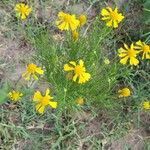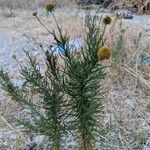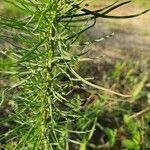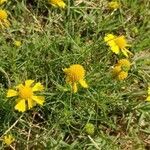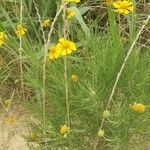Annual herb to 70 cm high. Stems glabrous, not winged. Leaves linear-filiform, fasciculate, 15–80 mm long, 0.3–0.5 mm wide, obtuse, very sparsely pubescent with tiny white patent hairs, densely glandular-punctate, not decurrent. Capitula numerous on slender peduncles; involucre 6–10 mm diam. at anthesis, 50–100-flowered; involucral bracts 2-seriate, linear-lanceolate to oblanceolate, 2.5–5 mm long, acuminate. Ray florets female; ligules 8–10, spreading, 6–14 mm long, yellow. Disc corolla 5-merous, yellow to yellow-brown; tube 1.5–2.2 mm long; lobes deltate, 0.5–0.6 mm long; anthers c. 1.2 mm long. Achenes 0.9–1.3 mm long, brown, with long antrorse hairs. Pappus of 6–8 obovate scales, 1.2–1.8 mm long; apex awn-like.
Taprooted, glabrous or atomiferous-glandular annual 2–5 dm; lvs very numerous, linear or linear-filiform, 1.5–8 cm, seldom over 2 mm wide; heads on short, naked peduncles extending above the leafy part of the plant; rays 5–10, pistillate, 5–12 mm; disk subglobose, yellow, 6–12 mm wide; pappus-scales commonly 6–8, ca 1.5 mm, the awn-tip about equaling the hyaline body; 2n=30. Prairies, open woods, fields, and waste places, especially in sandy soil; mainly Texan and Ozarkian, n. to Mo., but irregularly intr. e. to Conn., Md., Va., Ga., and Fla., and in Mex. and W.I. June–Oct. (H. tenuifolium) We have only the var. amarum, with yellow disk and entire lvs.
